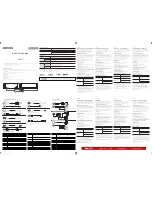
Pr
o
Minent
®
Page 18
Description and Function
1.1.3.4
Calibration vessels (vacuum tanks)
In version
CDKa
x
A
xxxxxXx,
optional calibration vessels
can be arranged next to the pumps
(30a, 30c). These are used when calibrating the pumps and serve during normal usage as
vacuum tanks
to collect gas pockets from the suction lines.
A short hose on the intake end of the pumps for acid and chlorite leads to a T between two
stop
valves
. The corresponding
suction line
is connected to the bottom of the stop valves
(30a.1, 30c.1). The calibration tanks are mounted above the stop valves (30a.2, 30c.2).
1.1.3.5
Flow monitors (ring initiators)
The task of the
flow monitor
(3a–c) is to ensure that both chemicals and water flow in the right
relationship during system operation.
If the volumetric flow of a component is reduced by more than 30 %, the flow monitor triggers an
alarm and switches off the system after eight missing pulses in a row.
The operating point must be set correctly by means of vertical adjustment of the sensors
(ring initiators) in order to ensure proper functioning of the flow monitors. From software version
3.13, the dosing monitors are also active during calibration and start up.
1.1.3.6
Metering valve
The
metering valve
(7) is located in the bypass line, installed in a
four-way piece
. The valve
opens at a reactor internal pressure of ca. 1.5 bar.
1.1.3.7
Bypass line
The chlorine dioxide solution produced (concentration = 20 g/l) is diluted in
the bypass line
and
fed to the main flow of water.
In the standard equipment of the system there are
ball valves
(20) but no bypass monitor. Various
options
for the bypass line are available (see fig. 22, ch. 9) according to the identification code
(see also ch. 1.1.1 Identification Code and ch. 1.4.2 Bypass Monitoring):
- Bypass (33) with
variable-area flow meter
and
minimum contact
to signal a minimum of flow.
- Bypass with
turbine wheel flow meter
and minimum contact (see ch. 1.1.3.9).
-
Non-return valve
(34)
-
premixing device
(60).
IMPORTANT
• The turbine flow meter cannot be used if the bypass water is enriched with chlorine
dioxide (e.g. in circuit systems).
• If a turbine wheel flow meter is used and bypass water is not free of solid particles,
a protective filter should be connected before the turbine flow meter (see ch. 1.5.4).
1.1.3.8
Systems without bypass monitoring
If the system
does not include bypass monitoring (33)
, the user must ensure that the system
will always shut down automatically and immediately when there is no flow of bypass water.
1.1.3.9
Systems with bypass monitoring
The control has an input for a
bypass monitor
. This ensures that no chlorine dioxide can be fed
without a flow of water in the bypass.The response value of minimal contact in conjunction with
the turbine wheel flow meter is set in the configuration menu (see ch. 5.2.4 “Bypass options”).
1.1.3.10 Component tanks, intake lances and intake fittings
The
component containers for chemicals
(e.g. 60 l drum) stand on the floor in front of the
system. The chemicals are fed by way of
intake lances
(31a, 31c). The length of the intake
lances must correspond to the size of the tanks, the diameter of the suction lines, and to the
capacity of the system (see table 20, ch. 1.5.7).
The intake lances contain a
two-stage level monitoring device
. If the amount of one of the
chemicals sinks to the first level, then the warning “acid level low” or “chlorite level low” lights up
on the control panel. A red LED “alarm” also lights up as warning (8, see fig. 11). The system
continues to run, and the relay “warning” is activated. In the second stage of the level monitoring,
Содержание Bello Zon CDKa 10000
Страница 57: ...ProMinent Page 57...
















































